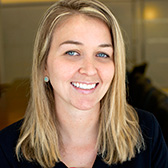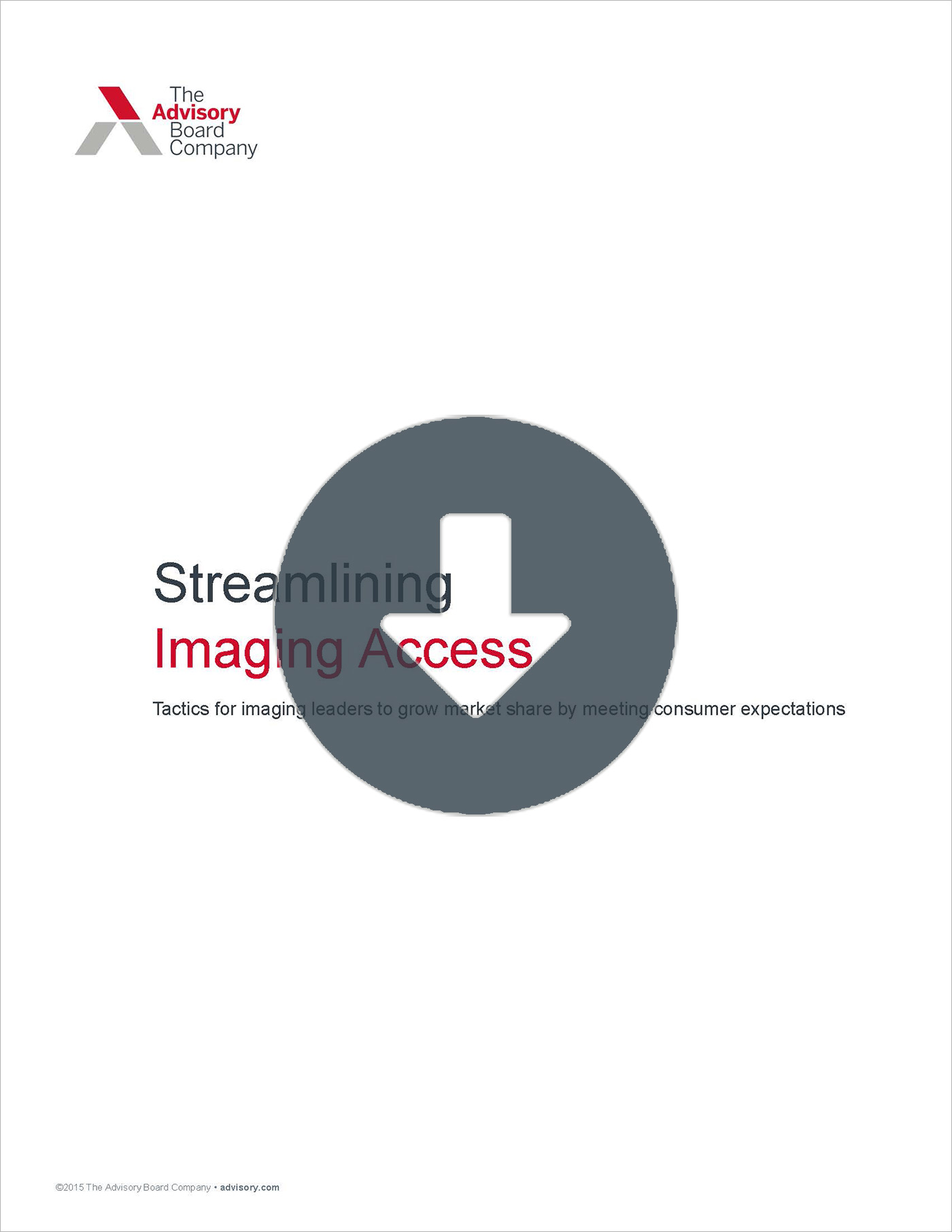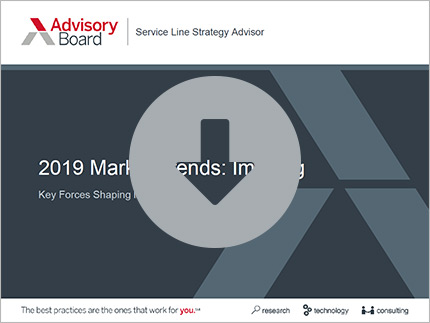Auto logout in seconds.
Continue LogoutRead Advisory Board's take: Why amenities alone won't keep mammogram patients
Hospitals and imaging centers are starting to offer spa-like amenities in spruced-up facilities to make the notoriously unpleasant routine mammogram more appealing to female patients, Stephanie Clifford reports for the New York Times.
'A literal pain'
While mammogram screening guidelines vary, in general, women are advised to get them regularly after a certain age. Many hospitals advise women to have one annually beginning at age 40, while the American Cancer Society recommends women start annual mammograms around age 45, then have them biennially starting at age 55.
But CDC data show many women aren't getting routine mammogram screenings in line with either of those recommendations. According to CDC, about one-third of women over 40 had not undergone a mammogram in the last two years.
One likely explanation for why women forgo mammograms is the unpleasantness of the procedure, Clifford reports. "Mammograms are such a literal pain—unless you are the kind of person who likes having her breast smashed against squeezing plates," she writes.
Shawna Peters, a cybersecurity recruiter in St. Paul, Minnesota, likened a mammogram to going to another infamously unpleasant appointment: "It's like going to the dentist, having your teeth cleaned," she said.
A new kind of mammogram experience
Hospitals and imaging centers around the country are taking note of patients like Peters and starting to offer a new kind of "mammoglam" experience, one that focuses on making patients more comfortable as they await and undergo the procedure, Clifford reports.
Fairview Health in Minnesota, where Peters goes, offers a "VIP night," where patients who receive a mammogram can get a chair massage, as well as goody bags with mints, lip balms, and pedicure accessories.
Fairview isn't the only provider that's rethinking the mammogram.
Robert Min, chair of radiology at Weill Cornell Medicine and NewYork-Presbyterian, last year oversaw the opening of a new imaging center and sought for the space to be "bright and lively," Clifford writes.
"Typically a lot of breast imaging facilities or OB-GYN facilities, there's a lot of pastels," Min said. Instead, at the new center, he went with "a bold accent" wall with large purple flowers, Clifford reports.
The facility also offers women personal lockers to hold their belongings while they're wearing gowns, which come in a range of sizes. In the space where women wait after changing, there's soothing music and adjustable lighting, Clifford reports.
"We're very conscious about, no one wants to be there— it's not like going to an Apple Store," Min said.
Solis Mammography, a multistate chain with about 50 clinics, similarly aims for a "spalike ambience," Clifford writes, with wooden floors, soft music playing, and even inspirational quotes on the walls.
Pure Mammography, an imaging center on Long Island, offers patients warm robes.
The business implications
The more-appealing mammogram carries several business benefits for providers, Clifford reports.
For one, women often decide where their family gets health care, and by appealing to female patients, health systems gain an entry point into the rest of the family.
Alex Merkulov—a radiologist and the head of women's imaging at UConn Health, which offers patients pretzels, graham crackers, and juice—said, "Women are known in their families to drive the decision of where health care is obtained by the family." He added, "Because we know this, we want women to come to UConn and be impressed with the facility, and then, if they have other non-screening needs, they would refer their friends, their family members, to UConn."
Providers that draw a high volume of imaging traffic also have better leverage when negotiating reimbursement rates with insurers, according to Laurence Baker, the chair of health research and policy at Stanford. Baker said hospitals can tell insurers, "'Hey, you need to have me in your network because patients want to come see me.'"
Further, Min noted that mammography insurance reimbursements are often low enough that providers lose money on them. Ellen Hoffman, the director of digital marketing at Solis, noted that operating on a larger scale can make mammogram services more profitable (Clifford, New York Times, 6/6).
Advisory Board's take


Deirdre Saulet, Practice Manager, Oncology Roundtable, Erin Lane, Consultant, Imaging Performance Partnership and Catherine Kosse, Senior Analyst, Imaging Performance Partnership
We commend these organizations for making breast cancer screening a priority, as we know that regular screenings are a tenet of population health and key to keeping women healthy. Still, it's worth noting that, while these flashy new upgrades may bring in some more patients, they are really only aimed at a small subset of the population. Thinking only about appealing to patients in this niche may distract from the extreme differences in the rate of screening access and adherence across racial and socioeconomic classes. For instance, we know that black women are 40% more likely to die of breast cancer than white women, even though they are less likely to develop breast cancer in the first place. Therefore, it's important that programs think holistically about the women they are targeting through screening programs, and target those who may be underserved. To learn more about how Duke Medicine used geospatial mapping to identify their at-risk populations, view our on-demand webconference here.
“What patients really care about is receiving fast care”
Furthermore, while nice amenities may attract new patients, our research shows that what patients really care about is receiving fast care with streamlined, appropriate follow-up. As this article mentions, "the other big reason that women don't get mammograms, according to Solis's research, is how much time an appointment takes." That's why programs that have consciously invested in streamlining screening appointments have not only been able to attract new patients, but also improve clinical outcomes. For instance, Massachusetts General Hospital implemented a new program that allows patients to receive same-day biopsies if their mammogram returns with suspicious findings. This increased the percent of patients receiving a same-day biopsy from 11% to 51%, and completely erased racial disparities in follow-up treatment.
This is just one strategy that programs can use to streamline care. We've also seen that best-in-class breast centers:
- Enable real-time radiologist reads: Station radiologists on-site or provide technology that enables radiologists to access images immediately after the exam. Then, create strong technologist-radiologist communication channels to promptly address patient history questions or paperwork issues. This approach ensures reads are completed efficiently and reduces potential delays in the patient receiving results.
- Leverage technology to streamline results delivery: Once the radiologist reads the exams, expedite the patient-friendly follow-up instructions with technology. Vendors, such as PenRad, allow programs to store multiple pre-templated follow-up letters with space for individual notes. Programs should ensure templates include language about breast density in preparation for the new federal proposal for breast density reporting language (see DenseBreast-info.org for more on the FDA's proposal). Additionally, radiologists must recommend next steps, such as an annual mammogram exam, a follow-up diagnostic exam, or a surgeon consultation.
Read the Blog Download the Report
Ready-to-present slides: Imaging market trends for 2019
Want the latest information for your next imaging meeting? This ready-to-use presentation—made in collaboration with the Imaging Performance Partnership—contains the Advisory Board's most popular slides on imaging market trends, from growth outlook and financial considerations to new imperatives for strategic planners.
Use the slides to frame your next strategy meeting and build a strong foundation for your presentation.
Don't miss out on the latest Advisory Board insights
Create your free account to access 1 resource, including the latest research and webinars.
Want access without creating an account?
You have 1 free members-only resource remaining this month.
1 free members-only resources remaining
1 free members-only resources remaining
You've reached your limit of free insights
Become a member to access all of Advisory Board's resources, events, and experts
Never miss out on the latest innovative health care content tailored to you.
Benefits include:
You've reached your limit of free insights
Become a member to access all of Advisory Board's resources, events, and experts
Never miss out on the latest innovative health care content tailored to you.
Benefits include:
This content is available through your Curated Research partnership with Advisory Board. Click on ‘view this resource’ to read the full piece
Email ask@advisory.com to learn more
Click on ‘Become a Member’ to learn about the benefits of a Full-Access partnership with Advisory Board
Never miss out on the latest innovative health care content tailored to you.
Benefits Include:
This is for members only. Learn more.
Click on ‘Become a Member’ to learn about the benefits of a Full-Access partnership with Advisory Board
Never miss out on the latest innovative health care content tailored to you.


